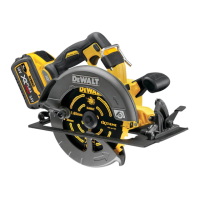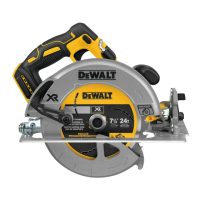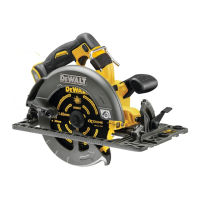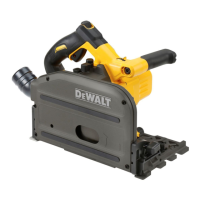ENGLISH
9
Worklight (Fig. A)
CAUTION: Do not stare into worklight. Serious eye
injury couldresult.
There is a worklight
15
located just below the blade lock
button
11
. The worklight is activated when the trigger
switch is depressed, and will automatically turn off 20
seconds after the trigger switch is released. If the trigger
switch remains depressed, the worklight will remainon.
NOTE: The worklight is for lighting the immediate work
surface and is not intended to be used as aflashlight.
Trigger Switch (Fig. E)
WARNING: This tool has no provision to lock the trigger
switch in the ON position and should never be locked ON by
any othermeans.
Release the trigger switch lock-off button
1
by pressing
the button as shown. Pull the trigger switch
2
to turn the
motor on. Releasing the trigger switch turns the motoroff.
Changing Blades (Fig. F, G)
WARNING: Remove battery from tool before
changingblades.
To install the Blade (Fig.F,G)
1. Retract the lower blade guard
7
using the lower blade
retracting lever
6
and place the blade on the saw spindle
against the inner clamp washer, making sure that the blade
will rotate in the proper direction (the direction of the
rotation arrow on the saw blade and the teeth must point
in the same direction as the direction of rotation arrow on
the lower blade guard). Do not assume that the printing on
the blade will always be facing you when properly installed.
When retracting the lower blade guard to install the blade,
check the condition and operation of the lower blade guard
to assure that it is working properly. Make sure it moves
freely and does not touch the blade or any other part, in all
angles and depths ofcut.
2. Place outer clamp washer
17
on saw spindle with
the large flat surface against the blade with beveled side
facingout.
3. Thread blade clamping screw
8
into saw spindle by
hand (screw has right-hand threads and must be turned
clockwise to tighten).
4. Depress the blade lock button
11
while turning the
saw spindle with the blade wrench
14
until the blade lock
engages and the blade stops rotating (Fig.G).
5. Tighten the blade clamping screw firmly with the
bladewrench.
NOTE: Never engage the blade lock while saw is running,
or engage in an effort to stop the tool. Never turn the saw
on while the blade lock is engaged. Serious damage to your
saw willresult.
To Replace the Blade (Fig.F,G)
1. To loosen the blade clamping screw
8
, depress the
blade lock button
11
and turn the saw spindle with the
blade wrench
14
until the blade lock engages and the
blade stops rotating. With the blade lock engaged, turn
the blade clamping screw counterclockwise with the blade
wrench (screw has right-hand threads and must be turned
counterclockwise to loosen).
2. Remove the blade clamping screw
8
and outer clamp
washer
17
only. Remove oldblade.
3. Clean any sawdust that may have accumulated in the
guard or clamp washer area and check the condition and
operation of the lower blade guard as previously outlined.
Do not lubricate thisarea.
4. Select the proper blade for the application (see Blades).
Always use blades that are the correct size (diameter)
with the proper size and shape center hole for mounting
on the saw spindle. Always assure that the maximum
recommended speed (rpm) on the saw blade meets or
exceeds the speed (rpm) of thesaw.
5. Follow steps 2 through 5 under To Install the
Blade, making sure that the blade will rotate in the
properdirection.
Lower Blade Guard
WARNING: The lower blade guard is a safety feature
which reduces the risk of serious personal injury.
Never use the saw if the lower blade guard is missing,
damaged, misassembled or not working properly. Do
not rely on the lower blade guard to protect you under
all circumstances. Your safety depends on following
all warnings and precautions as well as proper
operation of the saw. Check lower blade guard for
proper closing before each use as outlined in Further
Safety Instructions for All Saws. If the lower blade
guard is missing or not working properly, have the saw
serviced before using. To assure product safety and
reliability, repair, maintenance and adjustment should
be performed by an authorized service center or other
qualified service organization, always using identical
replacementparts.
Blades
WARNING: To minimize the risk of eye injury, always use
eye protection. Carbide is a hard but brittle material. Foreign
objects in the workpiece such as wire or nails can cause tips
to crack or break. Only operate saw when proper saw blade
guard is in place. Mount blade securely in proper rotation
before using, and always use a clean, sharpblade.
WARNING: Do not cut metal, plastic, concrete, masonry
or fiber cement materials with thissaw.
Do not use abrasive wheels or blades. A dull blade will
cause slow inefficient cutting, overload on the saw motor,
excessive splintering, and could increase the possibility of
kickback. Please refer to the table below to determine the
correct size replacement blade for your modelsaw.
RECOMMENDED BLADE TYPES
Combination Framing 5/8" Round arbor, 24 teeth
All purpose fast rip and
crosscuts
Pressure Treated/Wet
Lumber
5/8" Round arbor, 20 teeth
Coated, resistant to gum
build-up
Extreme Durability 5/8" Round arbor, 18 teeth
Coated, rock carbide
Finishing 5/8" Round arbor, 36 teeth
More teeth for finer finishcuts.
Fast Cut Framing 5/8" round arbor, 18 teeth
Fastest blade for rips and cross
cuts

